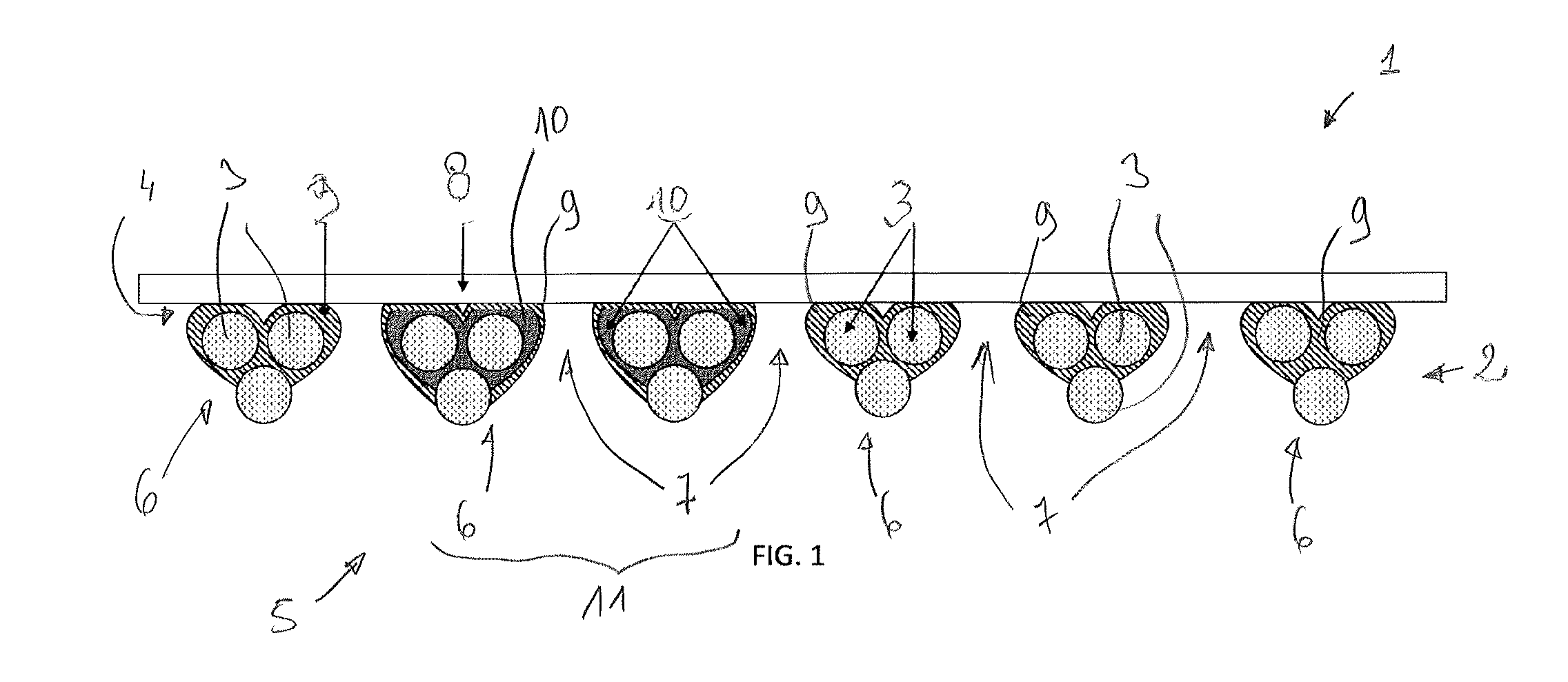Synthetic prosthesis comprising a knit and a non porous film and method for forming same
a non-porous film and prosthesis technology, applied in the field of tissue reinforcement synthetic prosthesis, can solve the problems of increasing the risk of making mistakes in follow-up surgery, prolonging the operating time, and not being favorable to the generation of adhesions, so as to reduce the number and amount of foreign materials, and improve the effect of tissue reinforcemen
- Summary
- Abstract
- Description
- Claims
- Application Information
AI Technical Summary
Benefits of technology
Problems solved by technology
Method used
Image
Examples
example 1
[0128]The present example describes the manufacture of knits suitable for the prosthesis of the invention.
[0129]1° Manufacture of Porous Knit A:
[0130]Knit A is produced by knitting on a warp knitting machine or a raschel knitting machine having two guide bars B1, B2, a monofilament of polypropylene of diameter 0.12 mm, the pattern followed for the knitting of the monofilament being the following, according to the ISO 11676 standard:
[0131]Bar B1: 1.2 / 4.5 / 4.3 / 4.5 / 4.3 / 1.0 / 1.2 / 1.0 / /
[0132]Bar B2: 4.3 / 1.0 / 1.2 / 1.0 / 1.2 / 4.5 / 4.3 / 4.5 / /
[0133]Guide bars B1 and B2 are threaded 1 full 1 empty and move symmetrically.
[0134]The knitting pattern of Knit A produces pores greater than about 1.0 mm in diameter. For example, some pores of Knit A have an average size of 2.0×2.4 mm. Such a large size of pores is very favorable for cell colonization and confers to Knit A a good transparency allowing a good visibility at the implantation site.)
[0135]2° Manufacture of Porous Knit B:
[0136]Knit B is obtained by ...
example 2
[0153]The present example describes the preparation of a marked knit suitable for the prosthesis of the invention.
[0154]Knit A of Example 1 is provided with markings in accordance with the following method:
[0155]a) Preparation of the Dying Solution:
[0156]A mother solution of 0.1% (w / v) of dye in methylene chloride is first prepared as follows: 200 mg of D&C Violet No 2 are added to 200 mL of methylene chloride with mixing.
[0157]The dying solution, under the form of a solution of 3% (w / v) of a polymer of ε-caprolactone in methylene chloride and 0.1% (w / w) of D&C Violet No 2 in a polymer of ε-caprolactone is then prepared as follows:
[0158]18 mL of the mother solution of 0.1% (w / v) of dye in methylene chloride is added to 582 mL of methylene chloride. 18 g of polymer ε-caprolactone are added to the solution with mixing. The mixing is continued until total solubilization of the polymer of ε-caprolactone.
[0159]b) Spraying of the Dying Solution:
[0160]A mask provided with void zones and fi...
example 3
[0169]The present example describes the manufacture of a sample of a prosthesis of the invention according to the method of the invention.)
[0170]1° Gluing of Knit A:
[0171]The first face of Knit A with marked zones as obtained at EXAMPLE 2 above is glued with a binding solution in accordance with the following method:
[0172]A solution of 3% (w / v) of a polymer of ε-caprolactone in methylene chloride is prepared as the binding solution.
[0173]The binding solution is then sprayed on the first face of Knit A provided with marked zones according to the following method: the spraying is performed with an ultrasonic spraying machine SONOTEK Flexicoat with a Sonotek 48 KHz Impact Nozzle and a microflow pump with the following conditions:[0174]Nozzle speed: 100 mm / s[0175]Height of the nozzle with respect to the knit: 40 mm[0176]Space between two nozzle passages: 8 mm[0177]delivery rate of the solution: 10 mL / min
[0178]The spraying is performed under the form of 3 passes of the spraying nozzle. D...
PUM
| Property | Measurement | Unit |
|---|---|---|
| diameter | aaaaa | aaaaa |
| porosity | aaaaa | aaaaa |
| thickness | aaaaa | aaaaa |
Abstract
Description
Claims
Application Information
 Login to View More
Login to View More - R&D
- Intellectual Property
- Life Sciences
- Materials
- Tech Scout
- Unparalleled Data Quality
- Higher Quality Content
- 60% Fewer Hallucinations
Browse by: Latest US Patents, China's latest patents, Technical Efficacy Thesaurus, Application Domain, Technology Topic, Popular Technical Reports.
© 2025 PatSnap. All rights reserved.Legal|Privacy policy|Modern Slavery Act Transparency Statement|Sitemap|About US| Contact US: help@patsnap.com



